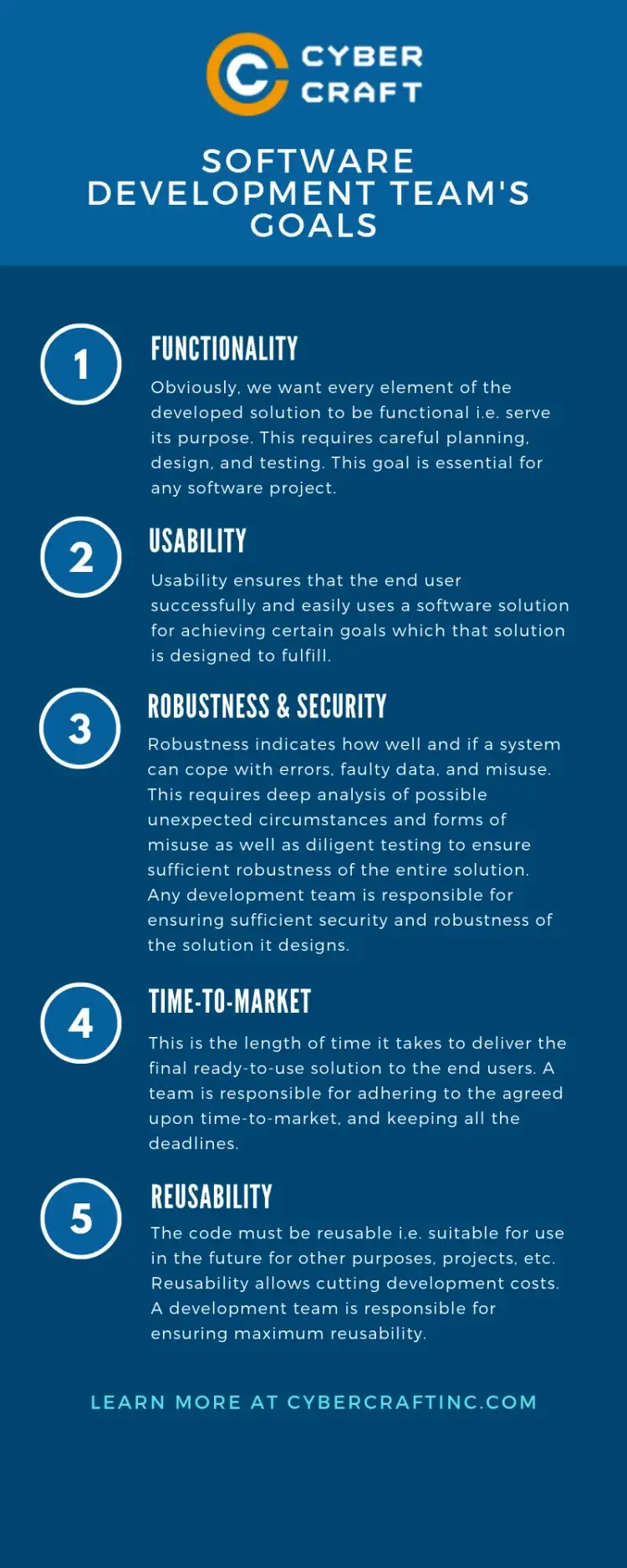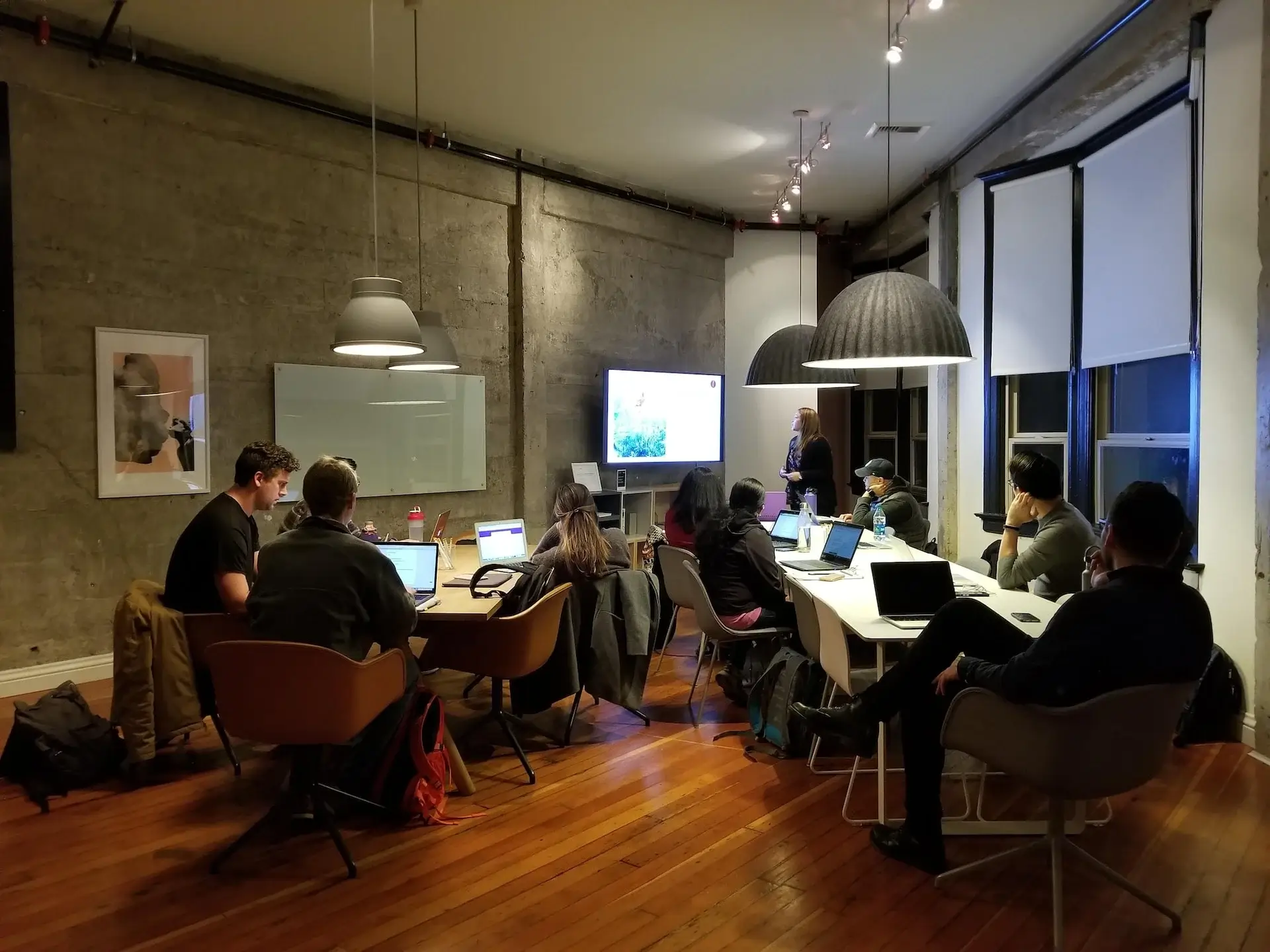Members of a Software Development Team
Are you wondering how a software development team is structured and organized? Who are its members, what are its goals and key performance indicators? What are the roles and responsibilities of each team member? Keep reading and you will find answers to these and many other important questions in this article.
Software development is a complex process which involves numerous stakeholders. Depending on the complexity, scope, and nature of a project, the team organization and size may vary. Many people have little or no idea how all of this works, and who besides software developers themselves are a part of a team. It’s exactly for this reason that we have created this comprehensive guide which describes all aspects of software development team organization and essential components of this process.
The first thing we’re going to talk about are the members of a team as well as their roles and responsibilities.
Members of a Software Development Team

Some people mistakenly assume that members of a software development team are only developers. In almost all cases, this is not correct. A team also includes other members who are not developers and do not code but fulfill other important functions necessary for achieving the objectives a software project. Let’s see the complete list of these members:
- Project Manager
- Functional Manager
- Team Leader
- Business Analyst
- QA Manager
- Change Manager
- Client
- Client’s Project Manager
- Test Engineer
- Database Administrator
- Developers
- Users
Yep, that’s a pretty big list. Also, frankly speaking, this is not even the maximum possible list. Some projects involve additional stakeholders absent from this list. We just included the most frequently demanded members. Let us review each role and its corresponding responsibilities.

Roles and Responsibilities of a Software Development Team
Every member will have a different set of responsibilities depending on his or her role in a project. It is also important to note that for each specific project these responsibilities and functions may vary depending on the peculiarities of that project. We are going to list the most widespread and generally accepted definitions and role descriptions of each.
Project Manager
This term means just that – someone who manages a project. Typical duties of a software project manager include:
- Creating a plan for a project
- Setting deadlines and ensuring they are met
- Recruiting
- Leading and managing team members
- Selecting and implementing the chosen software development methodology
- Creating and assigning tasks
- Communication with senior stakeholders/client, etc.
Hardly any project can get done without this individual. Almost all software projects include this role unless one of the developers takes on project management responsibilities. But one thing is always true – someone must manage a project. A project manager is this someone who does.
Functional Manager
This role implies working with a project manager and developers and acting as an intermediary between them. A functional manager tracks and evaluates the work and progress of developers and provides corresponding feedback to the PM.
Business Analyst
A business analyst participates in defining and clarifying project requirements and ensuring the deliverables correspond to them. A big part of his or her work involves documenting and testing deliverables.
QA Manager
A quality assurance (QA) manager is responsible for converting project requirements into working and functional testing scripts for ensuring that the product requirements are successfully met. These tests are known as a test plan.
Team Leader
A team leader has a vast range of responsibilities and functions. These include:
- Overseeing the technologies and tools used during development
- Acting as an intermediary between the client, project manager, developers, and other stakeholders
- Ensuring the deliverables correspond to requirements
- Implementing and controlling development standards and procedures
- Clarifying and understanding project requirements and translating them into detailed tech specifications
- Brainstorming and suggesting new solutions to clients’ need
- Ensuring timely delivery
Being a great developer is not enough for becoming a great team leader. This role also requires strong management and leadership skills.
Change Manager
Usually, this is not a single role but rather a group of people who are authorized to suggest, reject and accept changes to a project. When there are new suggestions, a change manager or a change board sit together and review them.
Client
Yes, a client is also a part of a team. He or she is involved in the development process to a certain degree. How high that degree is largely depends on the development methodology chosen. This individual or organization is the end sponsor who finances and orders development, provides requirements and feedback on the final product and deliverables.
Client’s Project Manager
In some cases, especially when a project is of significant size, a client will assign his or her own project manager to oversee the project and/or cooperate with the development team’s PM.
Test Engineer
A test engineer or just tester is a person responsible for creating test scripts and running them to identify any bugs and ensure complete correspondence to the client’s requirements. This role requires clear specification of test data and outcomes and their subsequent evaluation.
Database Administrator
A database admin is someone who creates and manages databases for specific software solutions. This requires sufficient understanding of a project’s needs and being able to design effective database solutions for meeting these needs.
Developers
Developers themselves or a project team are responsible for building the actual product and meeting the deadlines for deliverables. They are communicating with the team lead, project manager, and oftentimes other stakeholders such as the client, users, etc.
Users
The people who are going to use the final solution can be considered a part of the process as well. They can provide valuable feedback, report bugs, and various issues and even participate in determining initial product requirements. Usually, users actively participate in the testing process.
Now that we have reviewed the roles in a software development team and their corresponding duties, let’s analyze the main goals a team usually has.
Software Development Team Goals
Of course, every project is different and the goals set for each vary. However, it is safe to say that there are certain general principles and goals which every team seeks to achieve. We are going to analyze the most common ones.

Functionality
Obviously, we want every element of the developed solution to be functional i.e. serve its purpose. This requires careful planning, design, and testing. This goal is essential for any software project.
Usability
Usability ensures that the end user successfully and easily uses a software solution for achieving certain goals which that solution is designed to fulfill. For instance, if you’re building accounting software but users complain that it’s hard to calculate VAT taxes with it, then you have poor usability in that area.
Usability encompasses three main elements: satisfaction, efficiency, and effectiveness. Satisfaction means just that – how satisfied the end user is with the solution. Efficiency measures the speed of accomplishing a task. The higher the speed, the higher the efficiency. Effectiveness indicates how well a product fulfills a certain task. A software development team is responsible for ensuring sufficient usability of the product it builds.
Robustness & Security
Robustness indicates how well and if a system can cope with errors, faulty data, and misuse. This requires deep analysis of possible unexpected circumstances and forms of misuse as well as diligent testing to ensure sufficient robustness of the entire solution. Any development team is responsible for ensuring sufficient security and robustness of the solution it designs.
Time-to-Market
This is the length of time it takes to deliver the final ready-to-use solution to the end users. A team is responsible for adhering to the agreed upon time-to-market, and keeping all the deadlines.
Reusability
The code must be reusable i.e. suitable for use in the future for other purposes, projects, etc. Reusability allows cutting development costs. A development team is responsible for ensuring maximum reusability.
Having a great functional team and setting clear goals is not enough, however. It is also vital to define specific key performance indicators for a software development team which is what we are going to do next.
KPI for a Software Development Team
How does one measure the performance of a software development team? This is where key performance indicators (KPIs) enter the picture. They may vary depending on the nature of a project and team structure. We are going to list some of the most common ones below.

Cycle Time
Cycle time is the length of time it takes for an issue to move from one state to another, for instance, from open to finished. It is possible to measure a team’s speed of working on issues and completing them by deriving the median cycle time.
Velocity
Velocity measures the delivered value over a certain period. Delivered value represents the number of features developed. The best practice is to measure velocity over a few periods to come up with the average indicator.
Throughput
This metric is similar to velocity. However, it includes not only the features developed but the total output which also includes bugs and tasks over a certain period.
Open Pull Requests
This indicator measures the number of unresolved pull requests in a certain repository or in all of them. Now, what is a pull request? This is a developer’s request to the team to review his or her changes. Until he or she gets feedback, the request is considered open.
Work in Progress
This indicator represents the total number of issues under work at this time. If this indicator suddenly grows to a significant degree this means there are certain unaddressed issues. It is also useful for identifying inefficiencies in the workload.
Release Cycle Time
This metric indicates how much time a team spends on a release. This allows identifying possible inefficiencies and ways to cut the time between each release.
Having reviewed some of the most popular software development team KPIs, some readers may be asking: “So how do I select and organize a reliable team for my project?” This is exactly what we will answer next.
How to Find a Great Agile Software Development Team for Your Project

Based on our analysis, a few things become clear. First, let’s talk about the structure of your team. Undoubtedly, there should be a team leader and an experienced project manager. There must be one or more qualified testers and a QA manager. It also helps if there is going to be a business analyst and a change manager. The size and structure once again will depend on your project’s requirements.
Ensuring the correct team organization is not enough. The company you intend to sign a development agreement with must have a proven track record, experience with projects like yours in the past, official certifications, great testimonials, as well as clear and transparent cooperation terms. One such company is CyberCraft – a trusted offshore software development company from Ukraine which provides remote dedicated development teams at a low cost to clients from all around the world.
Final Words
We hope you found this brief guide useful and informative. Knowing about the roles, responsibilities, and duties of a software development team is essential for successful product development and project management. Understanding the major goals and performance indicators is also necessary for making your software project successful.
Remember, knowledge is power so the more you learn and know about software development and project management, the more successful your results in this field will be.




